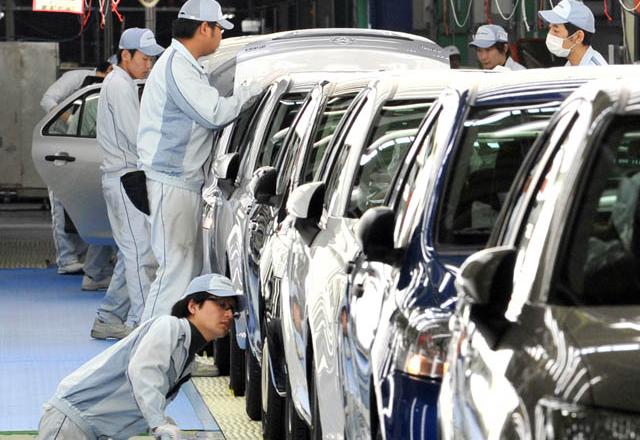TOKYO — Nissan said Monday its nine-month net profit jumped 18.4 per cent, capping a buoyant earnings season for Japan’s top three automakers thanks to a cheap yen and rising sales in North America and China.
Rival Toyota, the world’s biggest automaker, last week forecast a record annual profit with nine-month earnings more than doubling to $15 billion, after Japan’s number three Honda said its earnings surged almost 40 per cent.
The trio have been big winners over the past year as a sharp drop in the yen inflated exporters’ repatriated profits, further boosted by improved demand in key overseas markets.
Sales in China slumped in late 2012 and into last year as a Tokyo-Beijing diplomatic row sparked a consumer boycott of Japanese brands in the world’s biggest vehicle market.
Relations remain tense, but Japanese manufacturers have reported sales are returning to pre-dispute levels.
Nissan was particularly vulnerable as it counts on China for about a quarter of its sales and has been fighting off rivals, including General Motors and Volkswagen, to return to its pre-boycott 7.7 per cent market share.
In November, the new executive in charge of Nissan’s China business said the firm was struggling to catch up with rebounding demand, after a slow start in the first half of 2013.
The maker of the Altima sedan and luxury Infiniti brand has three plants in China with a local partner, and plans to open another factory this year.
On Monday, Nissan indicated that its net profit was 274.1 billion ($2.68 billion) in the April-December period, up 18.4 per cent, as profit in just the third quarter soared 57 per cent.
Global revenue of 7.27 trillion yen was up 19.7 per cent from a year earlier as Nissan pointed to a recovery in China as well as robust demand in Japan and North America.
‘Sluggish conditions’ in Europe
However, sales of 3.67 million vehicles were up just 1 per cent, as Nissan trailed its key Japanese rivals. Its Europe market struggled while Latin America and other parts of Asia turned down.
“Sales in Japan and North America helped offset emerging market volatility and sluggish conditions in Europe,” said the company’s chief executive Carlos Ghosn.
In November, Nissan downgraded its fiscal full-year profit outlook to 355 billion yen from 420 billion yen as higher-than-expected costs tied to vehicle recalls weighed on its bottom line.
The firm has announced a management shakeup on the heels of a broad restructuring at Renault, which owns more than 40 per cent of Nissan.
Ghosn has led an aggressive new product rollout plan, including resurrecting Nissan’s budget Datsun brand to woo a new generation of cost-conscious buyers in emerging markets.
However, Nissan has fallen behind Toyota and Honda while its bid to tap emerging markets has yet to be declared a success.
Toyota’s own developing-market focus was underscored Monday as it announced it will stop making cars in Australia, banging the final nail in the coffin of country’s auto industry.
Despite the buoyant figures so far, an April sales tax rise in Japan and a possible slowdown in US and Asian markets could put the brakes on sales for the Japanese auto sector, said Takaki Nakanishi, analyst and chief executive at Nakanishi Research Institute in Tokyo.
“The Japanese auto industry has been on the upswing thanks to the weak yen and strong demand in the US and Asia, including in Japan,” he added.
“But there are some negatives on the horizon. The sales tax hike in Japan will affect auto sales for sure, although I think the impact is likely to be limited. Also, the recent strong demand in Asia and America is likely to lose its momentum,” Nakanishi continued.
Gains from the weak yen will taper off, he remarked, while political unrest in Thailand, a major production base for Japanese automakers, could also dig into results.
Still, the upbeat results marked a firm recovery for Japanese automakers after the 2011 quake-tsunami disaster hammered production and disrupted their supply chains.
Separately, Nissan unveiled recently its version of London’s iconic black taxi, a market currently dominated by Chinese firm Geely.
Nissan claims its new 1.6-litre petrol engine taxi will be cleaner than the current diesel cabs being used in the British capital.
“The NV200 cab for London is part of Nissan’s global taxi programme, which also encompasses New York, Barcelona and Tokyo. The London version’s design is bespoke, reflecting the rich heritage and status of London’s black cabs,” the company said.
The new cab was first unveiled in August 2012, but after feedback from Mayor Boris Johnson’s office it has been redesigned to more closely resemble the black cab “face” with bigger headlights, a prominent taxi sign and a big front grille.
The new cab adheres to the strict regulations governing the capital’s black cabs — known officially as Hackney Carriages — including the required 7.6-metre turning circle.
The vehicle will be produced at Nissan’s existing plant in Barcelona and modifications will be added in Britain, home to the company’s huge Sunderland plant.
It will go on sale in London in December priced about £30,000 (49,250 euros, $36,000).
The company enters the market as the original maker of London’s famous black cabs finds a new life.
Chinese auto manufacturer Zhejiang Geely Holding Group last year rescued from bankruptcy what is now known as London Taxi Co.



















